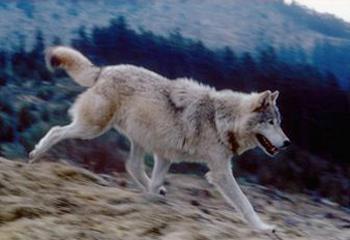
WASHINGTON, DC, June 11, 2013 (ENS) – The U.S. Fish and Wildlife Service is seeking public comments on its proposal to remove the gray wolf, Canis lupus, from the federal list of threatened and endangered species.
Announced late Friday, the Service says its proposal follows “a comprehensive review” that confirmed the “successful recovery” of gray wolves.
Since the gray wolf was listed under the Endangered Species Act over 30 years ago “management actions undertaken by federal, state and local partners” have contributed to the recovery of the species, the Service says.
The proposed rule would designate the Mexican wolf, Canis lupus baileyi, as an endangered subspecies. The agency is proposing to expand recovery efforts for the Mexican wolf in the Southwest, where it remains endangered.
Under the proposal, state wildlife management agencies would resume responsibility for management and protection of gray wolves in states where wolves occur.
Gray wolves were extirpated from most of the Lower 48 states by the middle of the 20th century, with the exception of northern Minnesota and Isle Royale in Michigan.

Then wolves from Canada dispersed south and began recolonizing northwest Montana in 1986. In 1995 and 1996, 66 wolves from southwestern Canada were reintroduced into Yellowstone National Park and central Idaho by U.S. federal agencies.
By 2002 the Northern Rocky Mountain population exceeded the minimum recovery goals of 300 wolves for a third straight year. They were delisted in the Northern Rocky Mountains in 2012 and Western Great Lakes in 2011.
Today, there are at least 6,100 gray wolves in the contiguous United States, with a current estimate of 1,674 in the Northern Rocky Mountains and 4,432 in the Western Great Lakes, according to the Service.
“From the moment a species requires the protection of the Endangered Species Act, our goal is to work with our partners to address the threats it faces and ensure its recovery,” said Fish and Wildlife Service Director Dan Ashe. “An exhaustive review of the latest scientific and taxonomic information shows that we have accomplished that goal with the gray wolf, allowing us to focus our work under the ESA on recovery of the Mexican wolf subspecies in the Southwest.”
The agency says its review determined that the current listing for the gray wolf, which was developed 35 years ago, “erroneously included large geographical areas outside the species’ historical range.”
But environmentalists believe the gray wolf deserves to stay on the Endangered Species List until recovery of the species is complete.

Jamie Rappaport Clark, president of the nonprofit Defenders of Wildlife and a former director of the U.S. Fish and Wildlife Service, said wolves currently inhabit only a fraction of their former range and are still missing from key states like Colorado, California and Utah.
“Having just a few thousand wolves in the Northern Rockies and Great Lakes is a far cry from what many of us envisioned for gray wolf recovery when we embarked on this ambitious conservation effort nearly two decades ago,” she said.
“Though wolf recovery has made significant progress so far, that is not an excuse to give up now when the job is only half done. Without additional protection and resources from the U.S. Fish and Wildlife Service, further gray wolf recovery in the United States may never occur,” said Clark.
Sierra Club Executive Director Michael Brune said, “Without federal protections this symbol of our wild heritage will slide back into harm’s way. We’ve seen the brutal assault on wolves that followed the loss of federal protections in Wyoming, Montana and Idaho. Increasingly hostile anti-wolf policies by states in charge of ensuring wolves’ survival don’t bode well for the future of this majestic creature.”
“Now is the time that we should be pressing in to finish the job of wolf recovery, not abandoning wolves to the same kinds of destructive forces that endangered them in the first place,” Brune said. “We urge the administration to preserve protections for these amazing animals until the success story is complete.”
The Service says this proposal is supported by governors and state wildlife agency leadership in each of the states with current wolf populations, as well as those that will assume responsibility for managing wolves dispersing into their states, such as Washington, Oregon, Colorado, Utah and North Dakota.
“With a solid state conservation and management plan in place for the Northern gray wolf, an experienced wildlife management agency that is committed to wolf recovery, and established populations recovering at an increasing rate, Oregon is ready to take on further responsibility for wolf management in this state,” said Roy Elicker, director of the Oregon Department of Fish and Wildlife.
“We know that there are questions that need to be resolved in moving toward a delisting of the Northern gray wolf under the federal ESA, and we believe the rulemaking process is an appropriate forum to address these issues,” said Elicker. “Oregon is supportive of the U.S. Fish and Wildlife Service publishing a proposed rule to begin this dialogue, and we look forward to participating in the scientific review process.”
“The Washington Department of Fish and Wildlife is firmly committed to the long-term persistence of wolves in Washington,” said Miranda Wecker, chair of the Washington Fish and Wildlife Commission. “The Washington Fish and Wildlife Commission believes the state should be responsible for the management of wolves and supports the U.S. Fish and Wildlife Service’s consideration of delisting gray wolves under the federal Endangered Species Act.”
Copyright Environment News Service (ENS) 2013. All rights reserved.
© 2013, Environment News Service. All rights reserved. Content may be quoted only with proper attribution and a direct link to the original article. Full reproduction is prohibited.
